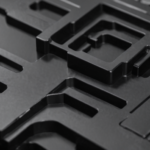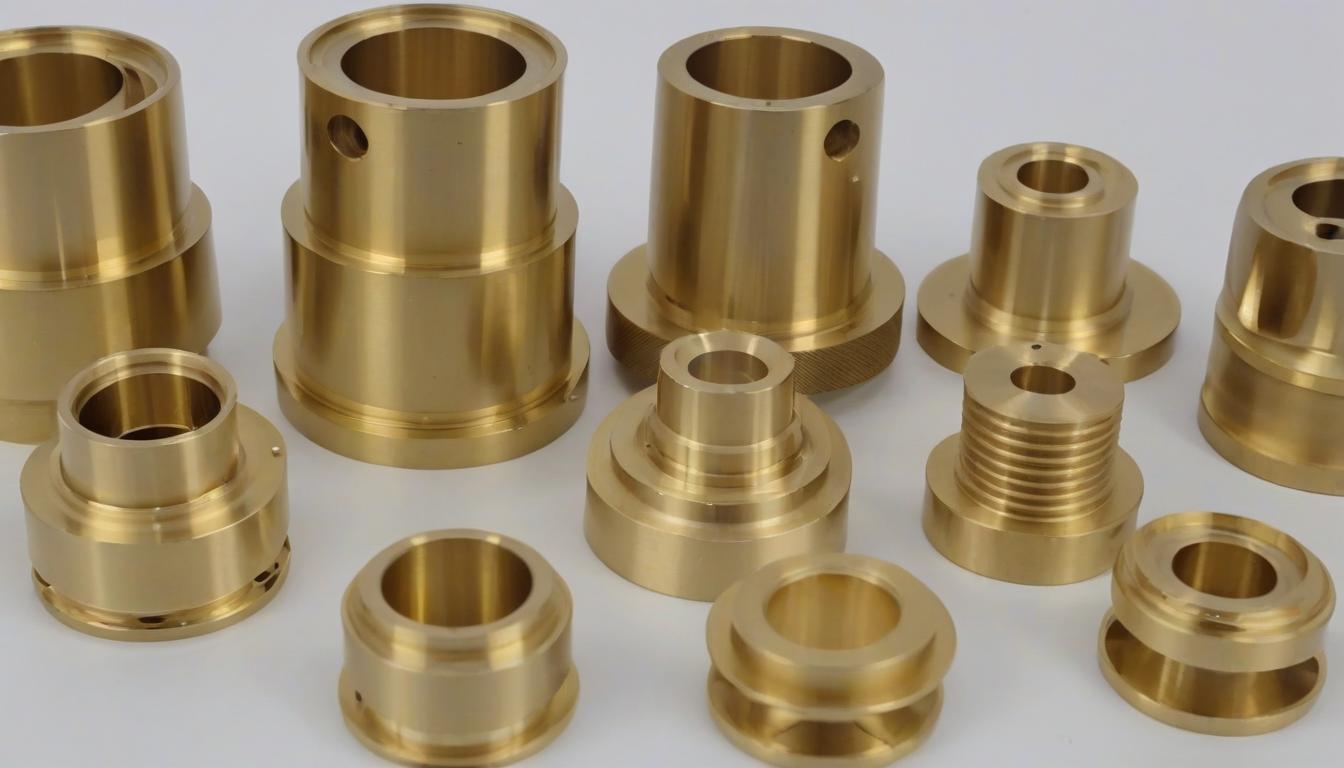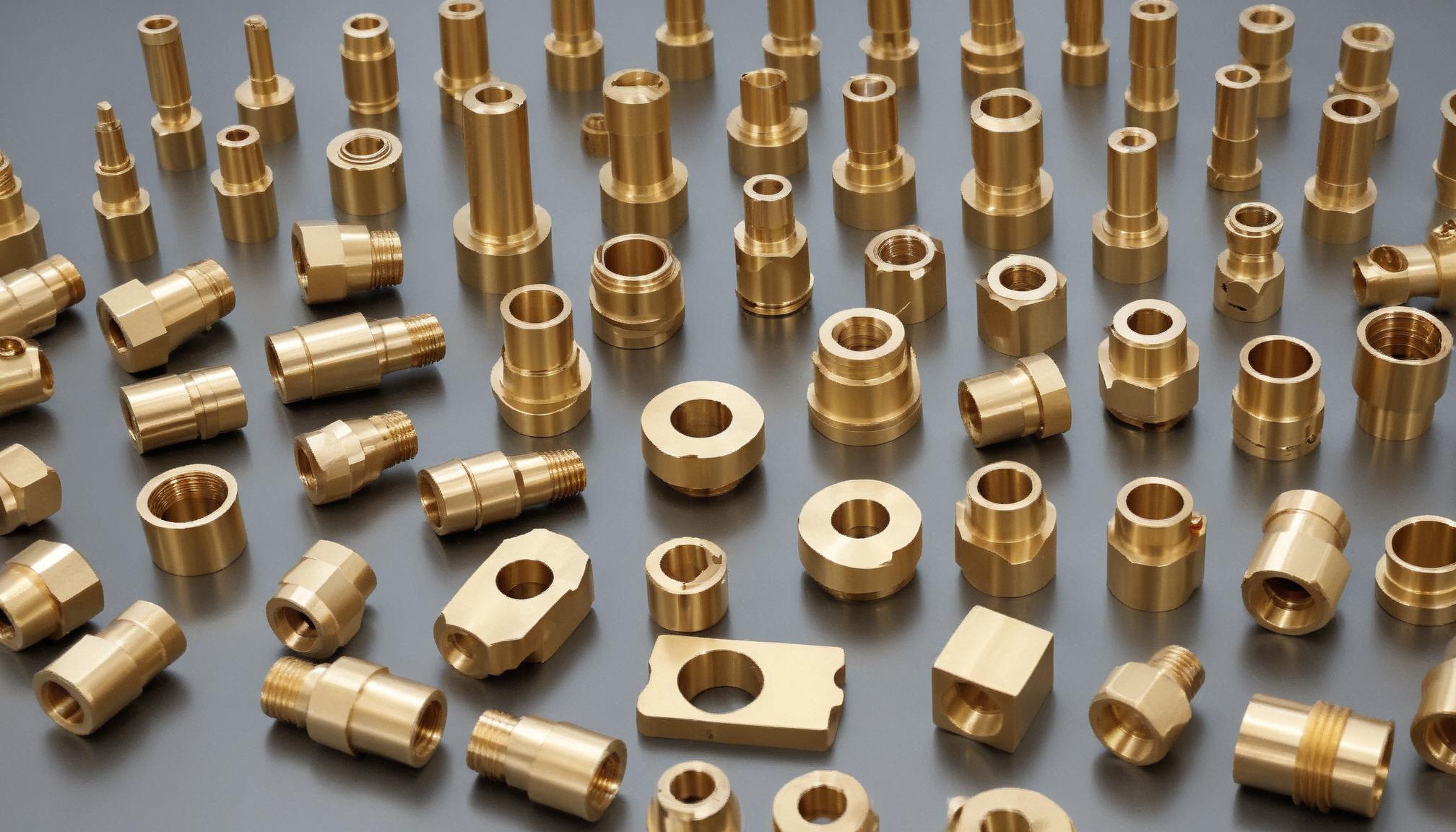
Anodizing in CNC Machining: Enhancing Durability and Aesthetics
18 July 2024
Controversy Arises Over Judging Machining Methods Based on Metal Chips and Debris
24 July 2024Introduction
CNC (Computer Numerical Control) machining is a manufacturing process in which pre-programmed computer software dictates the movement of factory tools and machinery. This process can control a range of complex machinery, from grinders and lathes to mills and routers. CNC machining is used extensively in various industries due to its ability to produce precise and intricate parts consistently and efficiently.
Brass, an alloy primarily composed of copper and zinc, is a highly versatile material known for its excellent machinability, corrosion resistance, and aesthetic appeal. These properties make brass an ideal choice for a wide range of applications, including plumbing fixtures, musical instruments, and precision components in various industries. Its ease of machining and desirable characteristics ensure that brass remains a popular material in CNC machining.
What is Brass?
Composition and Types of Brass
Brass is an alloy made from copper and zinc, with the proportions of each element varying to produce different types of brass. Common types of brass include:
- Alpha Brass: Contains less than 37% zinc and is known for its excellent corrosion resistance and ductility. It is often used in decorative applications and marine environments.
- Beta Brass: Contains 37-45% zinc and is harder and stronger than alpha brass. It is typically used in applications requiring higher strength, such as fasteners and mechanical components.
- Alpha-Beta Brass (Duplex Brass): Contains 45-50% zinc and exhibits a combination of properties from both alpha and beta brasses. It is used in plumbing fittings and valves.
- Leaded Brass: Contains a small amount of lead to improve machinability. It is widely used in applications where precision and ease of machining are critical, such as in the production of gears and bearings.
Properties of Brass
Brass is favored in many applications due to its unique combination of properties:
- Excellent Machinability: Brass is easy to machine, making it ideal for producing complex and intricate parts.
- Corrosion Resistance: Brass is resistant to corrosion, especially from saltwater, making it suitable for marine applications.
- Thermal and Electrical Conductivity: Brass has good thermal and electrical conductivity, making it useful in electrical and heat transfer applications.
- Aesthetic Appeal: The bright, gold-like appearance of brass makes it attractive for decorative purposes.
- Durability: Brass is strong and durable, making it suitable for a wide range of industrial applications.
Applications of Brass in Various Industries
Brass is used in numerous industries due to its versatility and desirable properties. Some common applications include:
- Plumbing: Brass is commonly used for pipes, fittings, and valves due to its corrosion resistance and durability.
- Electrical: Brass is used in electrical connectors, terminals, and switches because of its excellent conductivity.
- Automotive: Brass components are found in engines, radiators, and braking systems.
- Aerospace: Brass is used in various aerospace components due to its strength and resistance to corrosion.
- Musical Instruments: Brass is used to make instruments like trumpets, trombones, and saxophones because of its acoustic properties.
- Decorative Items: Brass is often used for decorative hardware, jewelry, and architectural features.

Benefits of Anodizing in CNC Machining
Precision and Accuracy
CNC machining allows for extremely high precision and accuracy, which is crucial when producing parts with tight tolerances. Brass, with its excellent machinability, is well-suited for CNC processes, ensuring that parts meet exact specifications consistently.
Efficiency and Speed
CNC machines can operate continuously, producing parts quickly and efficiently. This speed is beneficial for large production runs, reducing lead times and increasing productivity. Brass’s ease of machining further enhances the efficiency of the process.
Consistency in Production
CNC machining ensures that each part produced is identical to the last, maintaining consistency across large production runs. This repeatability is essential in industries where uniformity is critical, such as automotive and aerospace.
Cost-Effectiveness
While the initial investment in CNC machinery can be high, the long-term cost savings are significant. CNC machining reduces labor costs, minimizes material waste, and increases production speed, making it a cost-effective solution for manufacturing brass parts.
Versatility in Design
CNC machining allows for the production of complex and intricate designs that would be difficult or impossible to achieve with traditional machining methods. Brass’s malleability and machinability make it ideal for creating detailed and intricate components.
CNC Machining Processes for Brass
Milling
Overview of Milling Process
Milling is a machining process that uses rotating cutters to remove material from a workpiece, creating a desired shape. Milling can produce a variety of features, including slots, holes, and contours, making it a versatile process for machining brass.
Suitable Milling Tools for Brass
When milling brass, it is important to select tools that are designed for cutting non-ferrous metals. Carbide tools with sharp edges and appropriate coatings, such as TiN or TiAlN, are recommended for optimal performance.
Best Practices in Brass Milling
- Use Sharp Tools: Sharp tools minimize burr formation and improve surface finish.
- Optimize Cutting Parameters: Adjust spindle speed, feed rate, and cutting depth to achieve the best results.
- Apply Proper Coolant: Use coolant to manage heat and improve tool life.
Turning
Overview of Turning Process
Turning is a machining process in which a cutting tool removes material from a rotating workpiece. This process is used to create cylindrical parts and features, such as shafts and threads.
Suitable Turning Tools for Brass
Carbide tools with appropriate geometry and coatings are suitable for turning brass. Tools with a positive rake angle and sharp cutting edges are recommended for optimal performance.
Best Practices in Brass Turning
- Maintain Tool Sharpness: Regularly sharpen or replace tools to maintain cutting efficiency.
- Control Cutting Parameters: Adjust spindle speed, feed rate, and depth of cut to optimize the turning process.
- Use Coolant: Apply coolant to manage heat and improve tool life.
Drilling
Overview of Drilling Process
Drilling is a machining process that uses a rotating drill bit to create holes in a workpiece. Drilling brass requires careful control of cutting parameters to avoid issues like chip formation and material deformation.
Suitable Drilling Tools for Brass
High-speed steel (HSS) and carbide drill bits with appropriate coatings, such as TiN, are suitable for drilling brass. Split-point drill bits are recommended for improved precision and chip removal.
Best Practices in Brass Drilling
- Use Sharp Drill Bits: Sharp drill bits reduce burr formation and improve hole quality.
- Optimize Cutting Parameters: Adjust spindle speed and feed rate to achieve the best results.
- Apply Coolant: Use coolant to manage heat and improve drill bit life.
Choosing the Right Tools for CNC Machining Brass
Types of Cutting Tools
Various types of cutting tools can be used in CNC machining of brass, including end mills, drills, and turning tools. Selecting the right tool for the specific application is crucial for achieving optimal results.
Material and Coating of Cutting Tools
The material and coating of cutting tools play a significant role in their performance and longevity. Carbide tools with coatings like TiN, TiAlN, or diamond-like carbon (DLC) are recommended for machining brass due to their hardness and wear resistance.
Tool Geometry Considerations
The geometry of cutting tools, including the rake angle, clearance angle, and edge sharpness, affects their cutting performance. Tools with a positive rake angle and sharp edges are generally preferred for machining brass.
Tool Life and Replacement
Regular monitoring and maintenance of cutting tools are essential to ensure consistent performance and avoid tool failure. Establishing a tool replacement schedule based on the specific machining conditions and material properties can help maintain productivity and part quality.
Optimizing CNC Machine Settings for Brass
Spindle Speed and Feed Rate
Adjusting the spindle speed and feed rate is crucial for achieving optimal machining conditions. Higher spindle speeds and feed rates can improve productivity, but they must be balanced with tool wear and material properties.
Cutting Depth and Width
The cutting depth and width should be selected based on the specific requirements of the machining operation and the properties of brass. Shallower cuts can improve surface finish and reduce tool wear, while deeper cuts can increase material removal rates.
Coolant Usage and Lubrication
Proper use of coolant and lubrication is essential for managing heat and improving tool life. Coolants can help reduce friction and wear, while lubricants can improve chip evacuation and surface finish.
Machine Calibration and Maintenance
Regular calibration and maintenance of CNC machines are essential for ensuring accurate and consistent machining results. This includes checking machine alignment, inspecting and replacing worn components, and updating software as needed.
Designing for CNC Machining Brass
Design Considerations for Brass Parts
When designing parts for CNC machining, it is important to consider the properties of brass and the capabilities of CNC machines. This includes accounting for material properties, machining tolerances, and potential issues like burr formation and material deformation.
CAD/CAM Software for Brass Machining
Computer-aided design (CAD) and computer-aided manufacturing (CAM) software are essential tools for designing and programming CNC machining operations. These tools can help optimize tool paths, cutting parameters, and machining strategies for brass.
Prototyping and Testing
Prototyping and testing are important steps in the design and manufacturing process. Creating prototypes allows for testing and validation of the design, machining parameters, and material properties before full-scale production.

Quality Control in CNC Machining Brass
Quality control is paramount in CNC machining to ensure that machined parts meet the specified dimensions, tolerances, and surface finish requirements. Implementing rigorous quality control measures helps in maintaining consistency, minimizing defects, and delivering high-quality products. Here’s a more detailed look at various aspects of quality control in CNC machining brass:
Inspection Techniques and Tools
-
Coordinate Measuring Machines (CMMs):
- CMMs are used for precise measurement of the geometrical properties of machined parts. They can measure dimensions, angles, and alignments with high accuracy.
- These machines are ideal for complex parts with tight tolerances, providing detailed inspection reports that can be used for quality verification.
-
Optical Comparators:
- Optical comparators project magnified images of parts onto a screen, allowing for visual inspection and comparison against design templates or CAD models.
- They are particularly useful for inspecting profiles and edges.
-
Surface Roughness Testers:
- Surface roughness testers measure the texture of a part's surface, ensuring that it meets the specified finish requirements.
- These testers are crucial for applications where surface finish affects the functionality or aesthetics of the part.
-
Micrometers and Calipers:
- These handheld tools are used for quick and precise measurements of dimensions such as diameter, thickness, and length.
- They are essential for routine checks during the machining process.
-
Laser Scanners:
- Laser scanners provide high-resolution 3D scans of machined parts, allowing for detailed analysis and comparison with the original design.
- They are useful for inspecting complex geometries and ensuring that parts meet all specifications.
Tolerances and Surface Finish Requirements
-
Establishing Tolerances:
- Tolerances define the allowable deviations from specified dimensions. Tight tolerances are often required in industries such as aerospace, automotive, and medical devices.
- It’s crucial to establish appropriate tolerances based on the part’s function and industry standards to ensure reliability and performance.
-
Surface Finish Specifications:
- The surface finish of a machined part affects its appearance, functionality, and wear resistance. Specifications are usually given in terms of Ra (Roughness Average) or other surface texture parameters.
- Achieving the required surface finish involves selecting the right tools, cutting parameters, and post-processing techniques such as polishing or coating.
Common Defects and Troubleshooting
-
Burrs:
- Burrs are unwanted raised edges or small pieces of material that remain attached to the part after machining. They can affect assembly and function.
- To minimize burrs, use sharp tools, optimize cutting parameters, and consider deburring processes such as tumbling or manual removal.
-
Dimensional Inaccuracies:
- Dimensional inaccuracies occur when parts do not conform to the specified dimensions. This can be due to tool wear, machine calibration issues, or incorrect setup.
- Regularly calibrate machines, maintain tools, and use precision measurement tools to ensure dimensional accuracy.
-
Tool Marks:
- Tool marks are scratches or lines left on the part's surface by the cutting tool. They can affect the surface finish and aesthetics.
- To reduce tool marks, use appropriate cutting speeds, feeds, and ensure tools are in good condition. Implementing a proper coolant strategy can also help.
-
Heat-Related Issues:
- Excessive heat generated during machining can cause warping, discoloration, or metallurgical changes in brass parts.
- Use proper coolant and lubrication to manage heat, and optimize cutting parameters to minimize heat generation.
Implementing Effective Quality Control Measures
-
Process Monitoring:
- Continuously monitor the machining process using sensors and software to detect deviations and take corrective actions in real-time.
- Implement Statistical Process Control (SPC) to track and analyze process data, ensuring consistent quality.
-
Regular Maintenance:
- Maintain and calibrate CNC machines regularly to prevent wear and tear from affecting part quality.
- Schedule routine inspections and servicing of machines, tools, and accessories to ensure optimal performance.
-
Training and Skill Development:
- Invest in training for machinists and quality control personnel to enhance their skills and knowledge of CNC machining and inspection techniques.
- Provide ongoing education on the latest industry standards, tools, and technologies.
-
Documentation and Traceability:
- Maintain detailed documentation of the machining process, inspection results, and any corrective actions taken.
- Implement traceability systems to track parts throughout the manufacturing process, ensuring accountability and quality assurance.
Conclusion
CNC machining brass offers numerous benefits, including precision, efficiency, and versatility, making it a popular choice for various applications. However, it also presents challenges, such as tool wear and heat management, which require careful consideration and best practices to overcome. By understanding the properties of brass, selecting the right tools and machine settings, and implementing effective quality control measures, machinists can achieve optimal results and produce high-quality brass components. As CNC technology continues to advance, the potential for machining brass will only grow, offering new opportunities and applications in the manufacturing industry. Whether you are a novice or an experienced machinist, this comprehensive guide provides valuable insights and practical tips to enhance your CNC machining skills and achieve success in working with brass.




